Archive for April 2005
Spring in Kyoto: The Saga Continues!
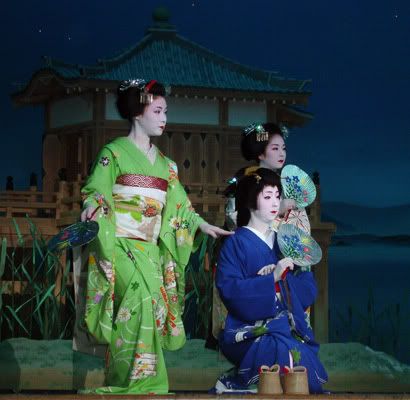
A geiko, Kyoto dialect for geisha, sits between two maiko.
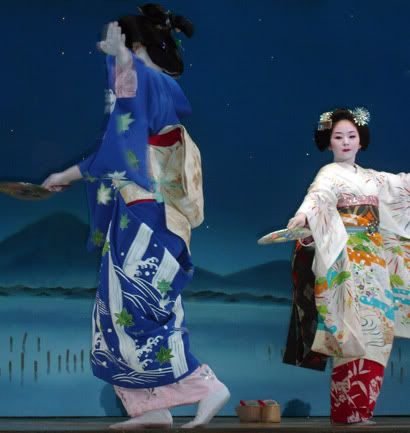
A geiko performs a summer night's dance on the shore of Lake Biwa, with one of the most beautiful maiko in Gion, Suzuha.

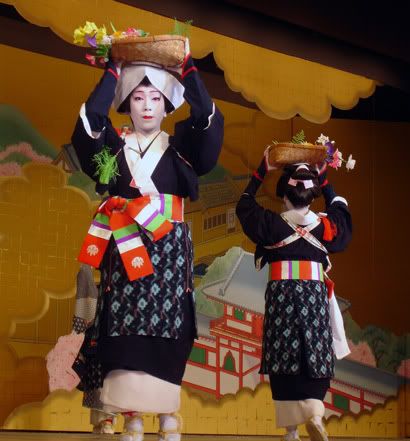
Geiko perform a dance depicting the ancient capital. This geiko is dressed in the traditional costume of the girls of Shirakawa, from Eastern Kyoto. EAST SIDE! Represent!
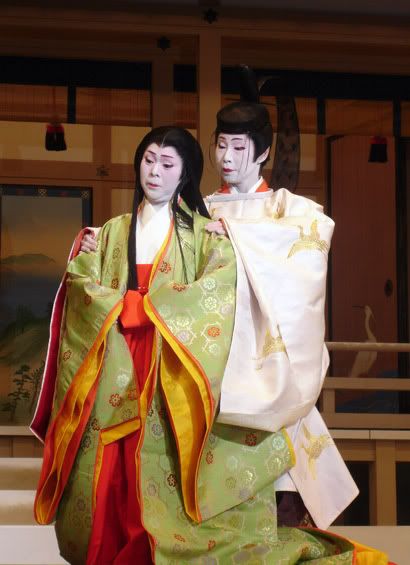
Geisha perform the snow scene in Uji, from the Tale of Genji, the first novel ever written (by Murasaki Shikibu).
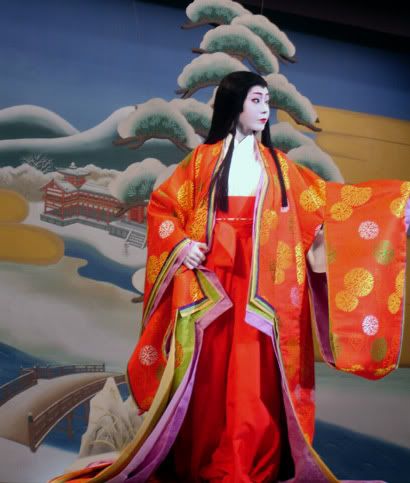
Heian beauty, Ukifune, from the tale of Genji. Torn between Prince Niou and Kaoru, she unsuccessfully tries to commit suicide by throwing herself into the Uji river. In the 10 Chapters in Uji, it is the only snow scene.
Spring in Kyoto Part I: Miyako Odori
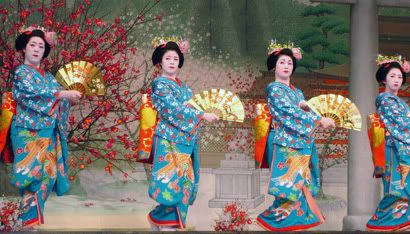
Miyako Odori, the spring dance of the Geisha and Maiko of Gion.
I can`t say that the Miyako Odori is something that I have wanted to see ever since I was a child...The truth is that I had no idea such beauty existed in the world. But ever since the first time I saw a Geisha slip out of a tea house in Gion and float gracefully down the cobbled streets like a white heron flying in the black of night, illuminated for only a moment by a ray of moonlight, I have been haunted by their ethereal beauty.

The Miyako Odori, which literally translates as the "Dance of the Capital", began in 1872, after the Capital was moved from Kyoto to Tokyo (during the Meiji Restoration). Afraid that Kyoto`s long tradition as the cultural center of the empire would quickly deteriorate, the Governor decided to hold an exposition in the Imperial Palace, asking the owner of a famous Ocahya (literally a tea house, but more specifically, a place where Geiko and Maiko entertain), to show a dance by a Geiko and a maiko to the public with the help of the master of Kyomai (Kyoto style of dance). Before then the maiko and geiko of Gion had never performed together as a group.
An excerpt from the 1933 Miyako Odori program:
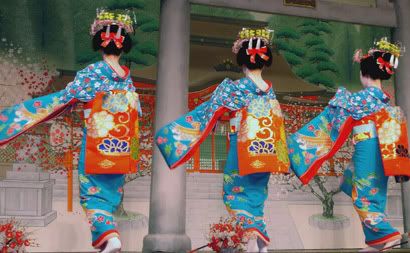
Ok. To be fair, there is no way that I could have been disappointed by this dance. If I even see one geisha or maiko walk down the street i get super excited. I have been known to break into a full sprint in an attempt to get a better view (or photo) even while wearing furisode kimono and zeta (formal Japanese sandals). Needless to say, being in a theatre full of them, with an amazing set, beautiful kimonos and traditional koto, shamisen and singing (all done by the girls themselves) equals one happy me minus all the running (which actually makes me even happier)! Even though I lost my breath every time I saw a maiko or geiko in Kyoto (not from running after them, just from their breath-taking beauty) I coulnd never have imagined how captivating, enchanting, and inspiring their perfomance would be. But how quickly it seemed to end, like a beautiful dream that fades away the moment you open your eyes.
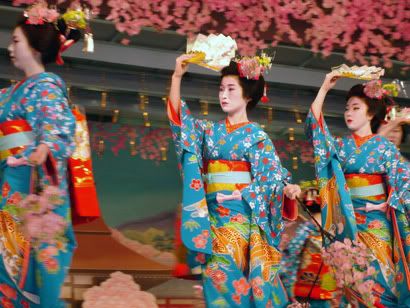

Maiko of Gion, the opening show of Miyako odori, April 1st.
As soon as I found out my mother and brother were coming to visit me (did I even mention that yet?) I knew I had to figure out a way to introduce them to the phenomena that is the geisha. I called and made reservations for the tickets 2 months in advance and made my mother promise to read Memoirs of a Geisha, by Aurthor Golden, just to give her a little background understanding of the Flower and Willow World. My brother was very skeptical about the whole thing. I don't think he was thrilled when I told him we were going to watch geiko and maiko dance. He may have been slightly more interested in seeing sumo, or something more 'manly'.
The exact opposite of sumo.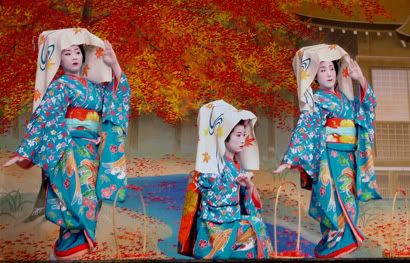
The beauty of fall in Kyoto. A scene from the Miyako odori performed by Gion`s most accomplished maiko.
Ofcourse once the show started I don't think there was anywhere else he'd rather have been. Our seats were amazing, second row back left of center, which means we were with in reach of the hanamichi, or flower path. The hana michi is a Japanese theatrical convention that allows performers to enter the stage by narrow paths that run along the sides of the audience. My brother was sitting next to some maiko's client, who proceeded to pull out his cell phone, showing my brother pictures of the two fo them together. When the lights dimmed, the curtains were raised on the sides of the hanamichi revealing a hidden orchestra. On the far side of the theatre, very old geisha began to pluck away at their shamisens. On our side the curtains lifted to reveal beautiful young maiko, who began to shout "Miyako Odori wa Yoiyasa!" (Welcome to Miyako Odori)! Some of them played Japanese flutes, as did the maiko that the man next to my brother had come to see, while others beat on small japanese drums.
Then the dancers began to make their way down the hanamichi.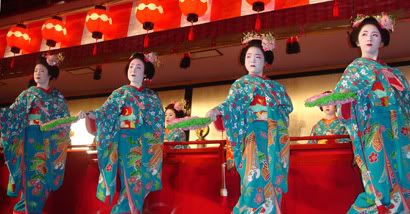
They were so close we could have touched them.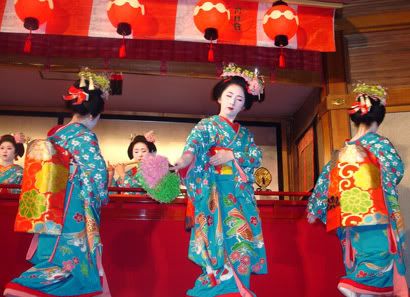
It was like the whole theater was one of those fantastic, old coockoo clocks! A huge Japanese coockoo clock!
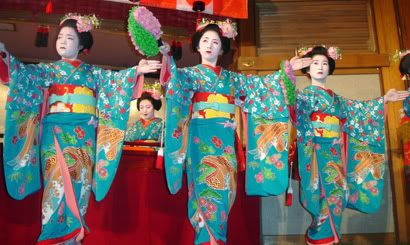
The maiko in the background being framed by the long sleeves of the dancers is the one the man next to my brother came to see.
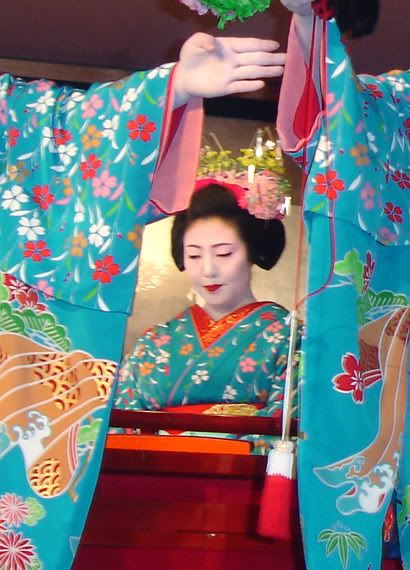
Its a little fuzzy, but that's her!
Before the show, two maiko actually performed a tea ceremony for the 'special' (special meaning paid the most) guests. From the moment you enter the room where tea is served, your eyes are drawn to them. Their beauty is not only physical, although some of the girls and geisha are strikingly beautiful. Its the way the way that they make every movement beautiful. They way they seem to hover between being a vision and being a reality. Through their mastery of the traditional arts, they actually become the art themselves.
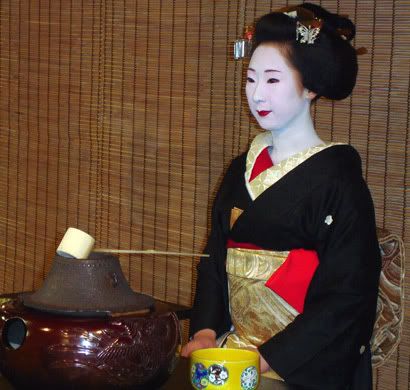
A maiko of Gion sits poised and still. Despite a whirlwind of photographers creating a lightning storm of flashes, she is unphased.
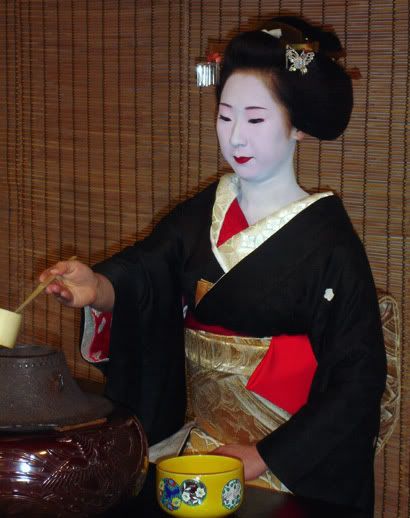
For most people, even Japanese, its very difficult to tell the difference between a Maiko and a Geiko. Many people think that Geiko only wear black and always wear a katsura, or especially styled wig. Maiko, like the woman above, do not wear wigs, like full fledged geiko, but have their own hair styled once a week. The woman above, however, is infact a geiko. Notice her white collar folded down to reveal a brilliant red. Although she has styled her own hair for the special occasion of performing the tea ceremony, this twist in her collar signifies that she is, indeed, a geiko.
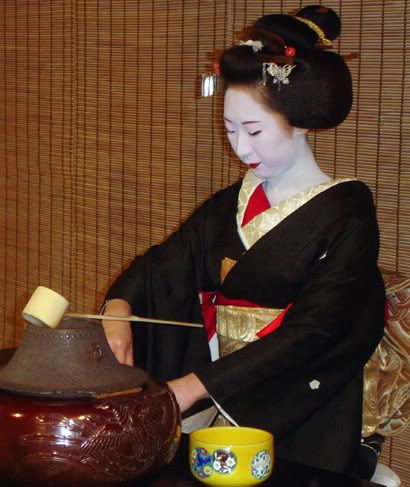
Tea is meditation. Every movement is diliberate. Tea bowls, like the yellow one above, are carefully chosen and can cost thousands of dollars.








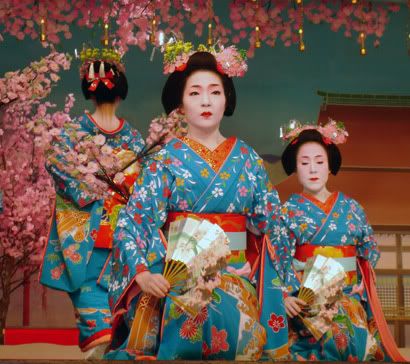


Las Adventuras de La Familia en Japon: この外人のお母さんと兄さんの日本の冒険!
My mother, brother, and I with the teachers of Ena Kita Jr. High. In back of my brother and I is the new, super-cute math teacher, at the ripe old age of 22! To the right of my bro is Katsuno sensei, who spent the evening teaching us how to fold origami, which is not easy for most gaijin when they are sober, let alone slightly intoxicated. The woman hiding behind Colin`s fat head (just kidding Colin:) is the coolest teacher I work with, and the organizer of this festive event: Kachi sensei, whose rice cooker recently exploded at 6:00 Tuesday morning, covering my kitchen in a gooey, green pea sludge.
The Gassho-zukuri style houses (so named because they resemble hands in prayer), of Shirakawa village are famous world-wide. The steep, peaked roofs help to keep the massive amounts of snow that falls in Northern Gifu from accumulating and crushing the house. The thatch, like so much else here, is made from a special kind of rice plant, and is about a meter thick.
Taking tea at the hearth of a gassho-zukuri home. The smoke from this ever burning fire, over the centuries, has stained the wood of the home a deep, glossy black (note the wall behind us). The noren (japanese style curtain) hanging behind was made by the home's owner from her grandmother's maiden kimono (its a meiji era furisode kimono, meaning a kimono she wore before she got married). It was stunning.
From the freezing snow of Northern Gifu we went south to Miyajima. My mother and I walked down to the shore rockin' our ryokan yukatas to watch the sun rise over the famous floating Torii. Of course, it only appears to be floating when the tide is in. My brother had woken up early and decided to climb up Mt. Misen in his yukata. By the time we woke up he was long gone, and didn't get back until almost 10:30.
The floating torii ( a spiritual gate that marks an entrance to a shinto shrine).
Our first night in Kyoto was also the first night of the Kiyomizudera Spring Illumination.
Kiyomizudera, the Temple of Pure Waters, shines like a star in the heavens☆.
Katsugiku, one of the many maiko and geiko my brother and I crossed paths with as we wandered the streets of Gion at night.
Phillipians 4:8
Kyoto turns pink in the spring, as clouds of blushing blossoms cling to the trees.
The Golden Pavillion, Kyoto.
Silly kid.
The joyful expression that only a plate full of fish head can bring.
Delicious! おいしい~!
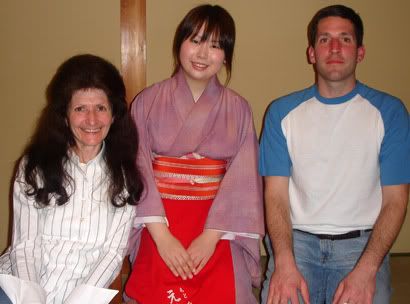
My mother made friends everywhere we went!
My three moms...
My host family from the good ol' Gaidai days.